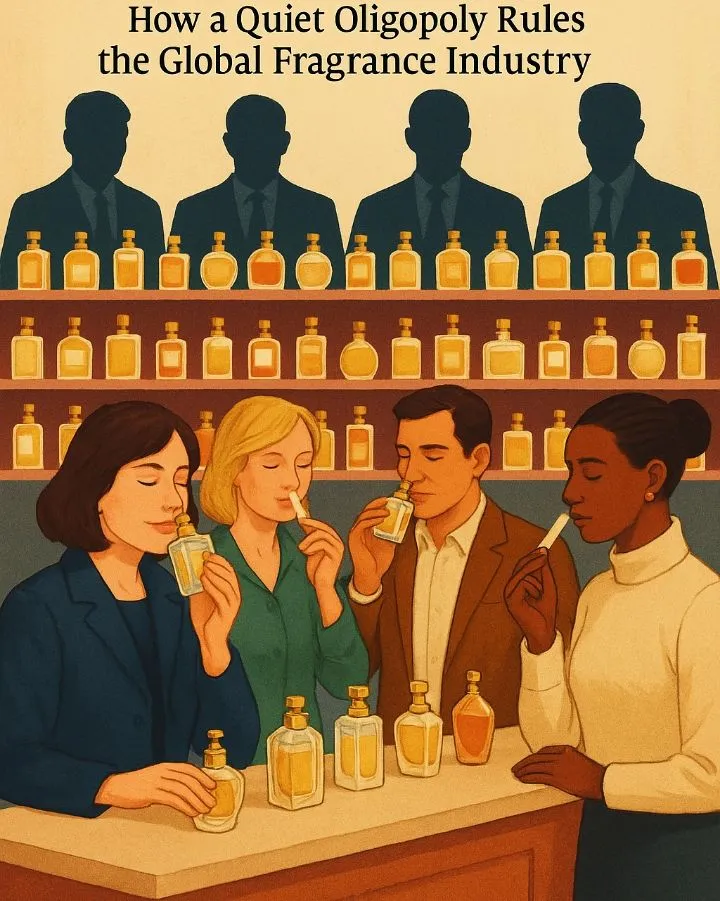
If you had strolled through the SIMPPAR expo in Paris this June, you’d likely catch whiffs of citrus, jasmine, and maybe something synthetic.
But beneath the intoxicating cloud of aromas, there was something else in the air that is control.
The global fragrance industry that conjures images of roses at dawn and artisanal charm has turned out to be dominated by a tight-knit circle of powerful players.
At SIMPPAR, suppliers from every corner of the world gathered to show off the raw ingredients that give perfumes their allure. From family-run Sicilian firms to Japanese chemical giants, the players are diverse. But the power is concentrated.
Behind the charming floral top notes of your favorite scent lies a silent oligopoly like a handful of ingredient makers who quietly hold sway over an entire multi-billion dollar industry.
Most of us associate fragrance with luxury brands like Chanel, Dior, Tom Ford. But the real architects of those perfumes are companies you have likely never heard of firms that supply the raw materials, both natural and synthetic, that make scent creation possible.
Take the centifolia rose, for example. Harvested at dawn when its scent is most potent, it has become a poetic symbol for natural fragrance. But nature, for all its romance, is unreliable. Weather patterns, climate change, and regulation have made ingredients like rose, ginger, or jasmine both expensive and unpredictable.
That’s where synthetics come in.
Synthetic molecules, engineered in labs, can mimic the scent of practically anything. They’re cruelty-free, more stable, and often cheaper. They also give perfumes what industry insiders call sillage and that is the ability to linger in a room long after you’ve left it. These molecules are the unglamorous backbone of modern perfume, and the companies that make them like Givaudan, Firmenich, IFF, and Symrise quietly dominate the market.
They don't just supply the tools for perfume-making. They shape what’s possible. And in doing so, they shape what we wear, what we remember, and how the world smells.
Despite their power, these suppliers are far from relaxed.
At SIMPPAR, grumbling was widespread. Deepu Nair of Greenleaf Extractions lamented that India’s ginger crops were ravaged by unpredictable weather. Laura Johnston of Ultra International, a Dutch essential oil company, pointed fingers at growing regulations that are making ingredient sourcing harder and more expensive.
European and global regulations are increasingly demanding traceability, transparency, and safety. That’s great news for consumers and the planet but a logistical nightmare for companies working with crops harvested in the wild, in small villages, or in unstable regions.
Meanwhile, competition watchdogs have begun sniffing around. With such market concentration among a few suppliers, antitrust questions are being raised. Who sets the prices? Who decides what gets prioritized? And are smaller, independent perfumers being squeezed out?
What makes all this fascinating is the contradiction at the heart of the fragrance world. Perfume is marketed as personal. It’s about you and your body chemistry, your mood, your story.
But behind that little glass bottle is an industry where control is increasingly impersonal, consolidated, and quietly corporate. Your “signature scent” might actually be crafted from the same raw materials as hundreds of other products from high-end colognes to household cleaners thanks to just a few global suppliers.
And yet, fragrance still works its magic. A well-crafted perfume can evoke emotion, unlock memory, or stir desire. That power hasn’t faded.
In the years to come, we may see more transparency in fragrance labeling. Consumers are increasingly curious, and conscious, about what they put on their bodies. There could also be more scrutiny from regulators and watchdogs. And possibly, a rise in indie perfumers who rebel against the control of the big four.
But the road won't be easy. Making perfume is as much science as it is art and the science, for now, still belongs to the giants.